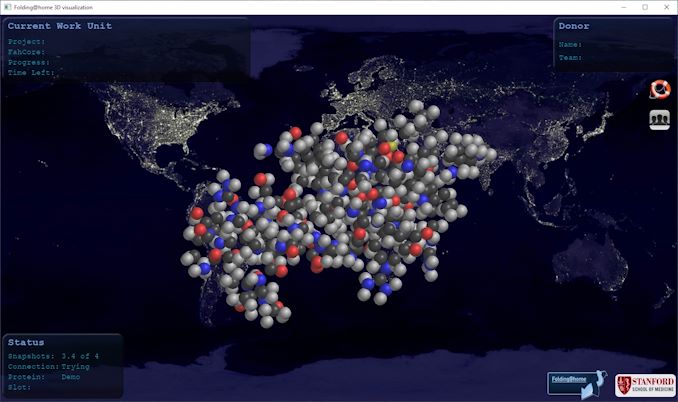Folding@Home Reaches Exascale: 1,500,000,000,000,000,000 Operations Per Second for COVID-19
by Anton Shilov on March 26, 2020 6:00 AM EST- Posted in
- Distributed Computing
- Exascale
- Coronavirus
- Folding@Home

Folding@home has announced that cumulative compute performance of systems participating in the project has exceeded 1.5 ExaFLOPS, or 1,500,000,000,000,000,000 floating point operations per second. The level of performance currently available from Folding@home participants is by an order of magnitude higher than that of the world’s most powerful supercomputer.
Right now, cumulative performance of active CPUs and GPUs (which have returned Work Units within the last 50 days) participating in the Folding@home project exceeds 1,5 ExaFLOPS, which is 10 times faster than performance of IBM’s Summit supercomputer benchmarked for 148.6 PetaFLOPS. To get there, Folding@Home had to employ 4.63 million CPU cores as well as nearly 430 thousand GPUs. Considering the nature of distributed computing, not all CPU cores and GPUs are online at all times, so performance available for Folding@home projects varies depending on availability of hardware.
| Folding@home Active CPUs & GPUs Reported on Wed, 25 Mar 2020 23:04:31 GMT |
||||||||
| AMD GPUs | NVIDIA GPUs | CPUs | CPU Cores | TFLOPS | x86 TFLOPS | |||
| Windows | 75,823 | 314,952 | 474,277 | 3,588,315 | 680,371 | 1,384,998 | ||
| Linux | 3,675 | 41,113 | 78,124 | 811,997 | 85,028 | 167,152 | ||
| macOS | - | - | 41,582 | 230,198 | 2,578 | 2,578 | ||
| Total | 79,498 | 356,065 | 593,983 | 4,630,510 | 767,977 | 1,554,728 | ||
| Note: | CPUs and GPUs which have returned Work Units within the last 50 days are considered Active. | |||||||
The outbreak of COVID-19 has been taxing for a number of computational biology and chemistry projects. IBM recently formed its COVID-19 High Performance Computing Consortium that pools together major supercomputers run by various research institutions and technology companies in the USA to run research simulations in epidemiology, bioinformatics, and molecular modeling. Cumulative performance of supercomputers participating in IBM’s COVID-19 HPC Consortium is 330 PetaFLOPS.
Folding@home distributed computing project uses compute capabilities to run simulations of protein dynamics in a bid to better understand them and find cures for various diseases. Recently F@H started to run projects simulating theoretically druggable protein targets from SARS-CoV-2, which attracted a lot of attention as SARS-CoV-2 and COVID-19 are clearly the hottest topics these days.
We at AnandTech also have our Folding@Home team, which are currently in a race against our sister site Tom's Hardware. If you have a GPU spare that's not too old, think about joining us in our battle. We are Team 198.
Related Reading:
- IBM & Partners to Fight COVID-19 with Supercomputers, Forms COVID-19 HPC Consortium
- Help Fight COVID-19 and Tom's Hardware: Join The Great Folding@Home Coronavirus Race
Source: Folding@Home Twitter










71 Comments
View All Comments
azfacea - Thursday, March 26, 2020 - link
sony removed the FAH app from ps3 in 2012 and nothing for ps4 or xbox. by my rough calculation there is probably 500 exaflops available from consoles thats not allowed to do anything right nowFlunk - Thursday, March 26, 2020 - link
I think lack of F@H on new consoles has more to do with the console makers not allowing it.azfacea - Thursday, March 26, 2020 - link
there was a guy who bet 2000 $ saying we wont get to exaflop by 2020. well is he gonna cough up the money now ??eSyr - Friday, March 27, 2020 - link
Horst Simon, and he was talking about single installation (like Cray Frontier, which is not going to be in operation until 2021, at least, according to the current roadmaps), supercomputer networks and other private datacenters surpassed 1 EF about year or two ago.azfacea - Saturday, March 28, 2020 - link
technically what u say is true. Although, many ppl in 2013-15 timeframe were projecting exaflop for 2025, they were far far far far off. Frontier is also 1.5 exaflop, probably using enhanced 7nm or better node. 1 exaflop would've easily been possible in 2020 within the same budget and power envelope, if some1 had ordered such a machine.plopke - Thursday, March 26, 2020 - link
I read here and there that they have issues with server capacity to actually process all the computing results? So is that Exascale number theoretical or actually what is/got achieved?Ian Cutress - Thursday, March 26, 2020 - link
As mentioned, it's the total FLOPS of devices that have submitted results in the last 50 days.The limit on FAH is actually storage bandwidth. They're working with Microsoft Azure to increase capacity - they spun up three 100 TB NVMe servers this week and it's still not enough.
plopke - Thursday, March 26, 2020 - link
Interesting thank you for the answer :)!Slash3 - Friday, March 27, 2020 - link
Linus Media Group is actually in the middle of firing up some solid state storage arrays for them to help out a bit, as well as working with their ISP to set up a high bandwidth node. Pretty cool.d0x360 - Friday, March 27, 2020 - link
Nowhere near enough.. I finished a data set 4 hours ago and I still can't connect to send it and if it doesn't get sent soon it will become invalid. I also can't get new data till it sends the old data and it can take hours to get new data.Sigh. I overclocked my 6 core i7 to 5.4ghz all core and my 2080ti ftw3 ultra which is already overclocked but I overclocked it in afterburner to +100 power, +157 core and +800 memory
Let's just say my living room temp literally went up 4 degrees and sounded like an airplane was taking off for 2 hours. Now I'm waiting and hoping it doesn't take so long my data becomes invalid.